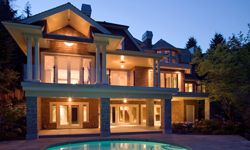 “Whether inside or out, lights are key to making a house a home.©iStockphoto.com/laughingmango
“Whether inside or out, lights are key to making a house a home.©iStockphoto.com/laughingmango
We’ve all been in rooms that just feel good. They have a palpable, comfortable atmosphere that makes you want to put up your feet and stay a while. Beyond the practicality of light, which is that we need it to see, the lighting scheme in your home has a big influence on the personality of a room. You wouldn’t want a bright overhead light shining down on an intimate dinner party or a single lamp lighting a space where you’re trying to do a project. The main goal of lighting design is to introduce varying degrees of light into a room, which are called layers. If you only have direct light sources, it will make a space feel dark and gloomy. And if you light the room evenly with no contrast, the room will appear flat and uninviting. Lighting is all about creating interest and visual drama, and these layers of light are parts of the whole that create the ultimate ambiance. Read on to be illuminated about lighting up your home.
Contents
- Ambient Lighting
- Accent Lights
- Task Lighting
- Natural Light
- Outdoor lighting
- Holiday Decorative Lighting
- Security Lighting
- Reflective Objects
- Mood Lighting
- Designer Lighting
10: Ambient Lighting
The purpose of ambient light is to create a diffused, even light level in a room, and it’s the first place to start when creating a lighting scheme. Ambient light can also refer to a lighting scheme as a whole, but for our purposes, we’ll be talking about ambient light sources. The source usually comes from lights on the ceiling, though sometimes table or floor lamps can do the trick. Overhead light sources can be a lone bright light, such as a ceiling or pendant light, or multiple lights, such as track lighting or recessed cans. These smaller lights all work together to create the main light source, but the difference is that they can be aimed at different areas of the room to get into all of the nooks and crannies.
Most overhead lights use incandescent bulbs, which are inexpensive and come in a variety of wattages. Compact fluorescent bulbs also have come on the scene as "green" alternatives that cost a little more but last considerably longer than their incandescent counterparts. They also have the benefit of being recyclable, whereas regular light bulbs are not. The downside is that fluorescent lights have a reputation for casting unattractive light, but manufacturers are continually working to improve this. No matter what bulb you use, overhead lighting is practical but it can be garish, so ambient light sources need to be complemented with other kinds of lights to provide contrast. In the next section, we’ll talk about accent lighting.
9: Accent Lights
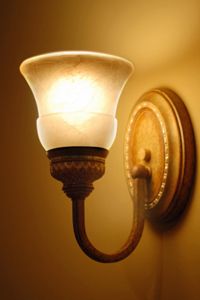 “Sconces are just one example of accent lights.©iStockphoto.com/ArtBoyMB
“Sconces are just one example of accent lights.©iStockphoto.com/ArtBoyMB
Accent lights are directional lights whose main purpose is to provide visual separation in a room. They’re secondary lights in a room, and as a rule of thumb, they should be three to five times brighter than the ambient light level [source: Light Bulbs]. Wall-mounted fixtures, such as sconces, are a good example of accent lights, as are table and floor lamps. For example, a chandelier in your dining room would provide ambient light, and one or more wall sconces would be the accent lights. Another use of accent lighting is to showcase a feature in a room, such as a painting or a collection. You’ve probably seen this in art museums. The ambient light is usually dim, which evokes peace and quiet, and the accent lights highlight the paintings, keeping you focused on the art. You can do this in your home as well, and it doesn’t have to be fine art. If you have a big, beautiful plant you want to highlight, you can put a spotlight on the floor behind it and let the light bounce off its leaves, creating shadows and drama. Typically, a spotlight or floodlight is used to accent an object, though tracklights also work in certain applications. Higher wattage incandescent bulbs are often used in table lamps and wall lights for accent lighting, and halogen lamps are primarily used in spotlights.
8: Task Lighting
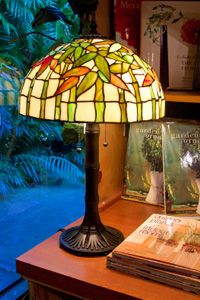 “It’s imperative to have the proper lighting when you’re trying to complete a task.©iStockphoto.com/Marje
“It’s imperative to have the proper lighting when you’re trying to complete a task.©iStockphoto.com/Marje
Task lighting provides the primary light in a room, and is ideally six to 10 times brighter than the ambient light. It’s used to increase illumination above ambient levels at workspaces, and carefully chosen task lighting can minimize the need for overhead lights, which is helpful in conserving energy. The term "task lighting" has noticeably popped up in the vernacular since home renovations have become all the rage. Task lighting for our ancestors often consisted of a bright lone bulb in a utilitarian desk lamp, but now the options are endless. It’s a key element in the kitchen and office, where specific tasks requiring proper light are prevent. It’s also useful in the living room for projects, or in the bedroom for reading, and helps to avoid eye strain. There are many different kinds of lights that perform the job of a task light. Under-cabinet down lights are helpful for kitchen tasks, because typically, your shadow gets in the way of the ambient light source. Desk lamps or floor lamps trained on a desk are useful in the office, and table lamps with high watt bulbs work well in the living room and bedroom. Halogen lights are ideal for task lighting because they’re energy efficient and produce a clean, clear light that renders accurate colors. The downside is that they tend to burn hot, so computing for hours under a halogen bulb could produce a sweat bead or two.
7: Natural Light
When asked to describe their most coveted space, many homeowners are quick to toss out adjectives like light and airy. Natural light is highly desirable light in a home, simply because it makes everything look appealing. Lighting schemes relying on natural light are called daylighting, and builders and architects are getting more requests than ever before to implement it in new construction. Perhaps it’s because we spend many of our busy hours sitting at a desk indoors, but we didn’t evolve that way. Daylighting keeps us in touch with the outdoors and time of day, and studies have found that people who work in natural light are more productive [source: Mother Earth News]. There are other benefits to natural light as well, such as a savings on electricity if you don’t have to turn on lights. But making the best use of natural light is more detailed than throwing open your curtains and embracing the sun’s rays. Glare can be an issue if the sun shines directly, or even indirectly, into the room. Heat also needs to be managed, which is usually best accomplished with curtains or shades. Painting a room a light, reflective color can help amp up the natural light, and the best ceiling color to complement the light is the whitest white you can find.
6: Outdoor lighting
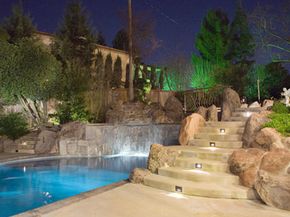 “Landscape lighting will keep your yard safe — and pretty to look at.©iStockphoto.com/Slobo
“Landscape lighting will keep your yard safe — and pretty to look at.©iStockphoto.com/Slobo
People are incorporating a lot more outdoor living into their lives at home, and for this reason, outdoor lighting needs to be approached with the same principles as indoor lighting. Ambient, accent and task lighting all serve their purpose in an outdoor lighting plan.
Accent lights can be used to highlight particular features in your yard. Smaller trees are great showpieces in a spotlight, and larger trees can reflect light back into the yard. Flowerbeds benefit from ground lighting that adds drama and beauty to your yard scene. And if you get the itch to do a little gardening at night, ground lights can also provide good task lighting.
If you have a deck with built-in seating, downlights add the feeling of candlelight for an intimate scenario. You don’t want to over-light, so a good rule of thumb is to come up with a lighting scheme that mimics moonlight. You can choose from a variety of solar lights which are charged by sunlight, or low-voltage lights that connect to the electricity in your house. Solar lights are typically less expensive, but they also don’t give off as much light. Low-voltage lights are more expensive and require additional equipment, but they offer considerably more light.
5: Holiday Decorative Lighting
Holidays — and especially Christmas — really come alive through lighting. Whether you’re trying to create a fun, festive atmosphere or a more intimate one, both can easily be accomplished through your selection of interior and exterior lighting. Colorful lights strung outside can incite instant cheer in those about to enter your home; follow up inside with festive lighting on your tree, plus splashy accent lighting. Accent lighting can be anything from string lights to lighted pine garland to strategically placed blinking deer. For a more subdued, stylish look, swap out the colorful strands for white lights, plus incorporate accents such as candles, lanterns and luminaries, both near the fireplace and on your outside steps. Finally, tuck in some items with metallic finishes near your lights or candles, which will cause a sparkling, shimmering aura.
4: Security Lighting
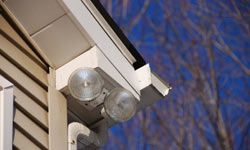 “Bright, motion-controlled lights are a popular way to add some security to your home.©iStockphoto.com/StushD80
“Bright, motion-controlled lights are a popular way to add some security to your home.©iStockphoto.com/StushD80
All of the lighting we’ve discussed so far has been aimed at ambiance, but lighting for security is an important consideration, too. This encompasses everything from scaring off potential thieves and destructive animals to illuminating areas and objects that may cause you or your guests to stumble.
Some people think security lighting is an easy thing — just slap up a bright, motion-controlled light near your home, and maybe toss in some lights along your walkway. But achieving good results takes a little more thought. Keep these points in mind when planning your security lighting:
- To ward off thieves and assailants, it’s better to install a shielded, medium-intensity light rather than a super-bright light. You may feel safer with a bright light, but it will inhibit you from seeing who’s out there or what’s going on. A dimmer one will allow you to jot down descriptions, license plate numbers, etc. for authorities, if necessary [source: Residential Landscape Lighting & Design].
- Motion detectors are great at both security lighting and energy management, as they only go on when there’s movement in the area. Position them high enough — ideally, under the eaves — so they can’t be easily disabled or destroyed by intruders, and in a downward position so you don’t illuminate your entire block. And remember animals and blowing objects can set them off, not just intruders.
- Do a few checks before actually installing your security fixtures. Will a bright light hit you in the face when you open the front door, or blind your guests as they get out of their cars? Can you perhaps hide a not-so-pretty light within your landscaping? If you’re just trying to keep feral cats out of your backyard, do you really want lights around your entire home [source: Hannigan]?
3: Reflective Objects
Many people overlook the use of reflective objects — such as mirrors, crystal and glass — in adding light to their homes. If properly placed, such objects can go a long way toward illuminating a room. Floor-to-ceiling mirrors, for example, can really lighten dark rooms, plus make them seem larger. Smaller mirrors can be set over mantels, or hung on the wall like pictures, to throw back smaller amounts of light [source: The Telegraph]. For tiny sparkles, place mirrored votive candleholders on tables or in dark corners.
Much smaller crystals are great at catching the sunshine and casting it playfully around a room. You can purchase reflective crystals — often prisms — for just a few bucks, and place one or more in a window or two. They can be clear or any color you wish [source: The Telegraph].
And don’t forget your fireplace. Firelight is magical just as it is, but you can also purchase reflective fireplace glass that you sprinkle at the base of your fire. The glass pieces are chunkier than regular fire glass, which gives the flames more surface area to reflect off of, resulting in an enchanting, dancing light. Like crystals, they come in a variety of colors [source: Blazing Glass].
2: Mood Lighting
 “The warm light from a fireplace can help make a room feel cozier.©iStockphoto.com/oneword
“The warm light from a fireplace can help make a room feel cozier.©iStockphoto.com/oneword
Like paint, lighting can dramatically change the feeling of a room. And you probably don’t want to elicit the same feelings in every room of your home. Want to create a cozy space? Add lots of reading lamps to the room, and wall sconces or torchieres, which create a warm glow. A fireplace always elicits a comforting feeling, too. To encourage an energetic mood, you want to couple bright ambient lighting with very focused task lighting. Recessed strip lighting, for example, is great in the combination desk-bookcase units popular for home offices. And multi-bulb fixtures make an entire room brighter, allowing you to easily see detail, whether in a cake you’re decorating or a miniature railroad you’re assembling. Need a romantic hideaway? Nix overhead lights in lieu of several small lamps with warm or dark-colored shades. If you add sconces, place them lower on your wall than normal; this will make the ceiling look lower and the room cozier. And don’t forget those all-important dimmer switches [source: GE Lighting].
1: Designer Lighting
Similar to mood lighting, the use of designer lighting can change the feel of a room. But whereas mood lighting changes the feel of a room — from, say, energetic to romantic — designer lighting changes the personality or style of a room. A good example is the newly popular "man cave," a room for the man of the house that’s typically filled with sports and drinking memorabilia, a huge TV and perhaps a foosball table, pool table or dartboard. Add to the personality of this room with designer lighting such as sports lamps and, if the room includes a bar, a neon sign. Baby on the way? Prepare the nursery by installing colorful gumdrop pendant lights over the changing table and perhaps a bunny table lamp. For the nightlight? Maybe a smiling moon.
But designer lighting doesn’t have to be quite so specific. If you have a modern home with sleek, contemporary lines, seek out the same in your lighting to carry through the same style. Install a saucer bubble pendant light over the kitchen table, for example, or a curving monorail lighting system over your island. Fixtures with geometric shapes and natural materials are what you’re seeking. Not surprisingly, it’s the opposite for those who favor a traditionally styled home. Look for pieces such as ornate chandeliers, fixtures with painted, bronze or brushed pewter finishes and overall elegance [source: Kichler].
Lots More Information
Related HowStuffWorks Articles
- 10 Lighting Tips
- How Solar Cells Work
- Lighting Quiz
- Mood Lighting
- Solar Cell Quiz
- How Solar Cars Work
- How Solar Yard Lights Work
- How the Sun Works
- How Light Works
Sources
- Blazing Glass. "1/2" Reflective Fire Glass." (Jan., 12, 2012) http://www.blazingglass.com/half-inch-reflective-fire-glass/
- Burns-Millyard, Kathy. "Home Decorating: Choosing The Right Lights for Your Look and Needs." Myinteriordecorator.com, 2007.http://myinteriordecorator.com/home-decorating-lighting.html
- Freshome. "How to Warm your Holiday Home with Festive Lighting." (Jan. 10, 2012) http://freshome.com/2011/11/22/how-to-warm-your-holiday-home-with-festive-lighting/
- GE Lighting. "Mood Lighting." (Jan. 10, 2012) http://www.gelighting.com/na/home_lighting/design_with_light/mood.htm
- Hannigan, Elizabeth. "Most Effective Outdoor Security Lights." Home & Garden Ideas. Jan. 18, 2011. (Jan. 10, 2012) http://www.homeandgardenideas.com/home-improvement/electronics/security-systems/most-effective-outdoor-security-lights
- "How To Get The Best Home Lighting." Channel4.com, October 6, 2008.http://www.channel4.com/4homes/design-style/how-to-guides/how-to-get-the-best-home-lighting-08-06-10_p_1.html
- "Indoor Light Bulbs." Lightbulbs.org, 2009.http://lightbulbs.org/indoor-light-bulbs
- Kichler. "Traditional." (Jan. 12, 2012) http://www.kichler.com/consumer/products/catStyle/TRADITIONAL
- Kinnaird, Glen. "Dos And Don’Ts [sic] For Using Holiday Lights." MiNeeds. Nov. 17, 2009. (Jan. 10, 2012) http://www.mineeds.com/New-York/Kinnaird-Designs-Interiors/Articles/Dos-and-Donts-for-using-Holiday-Lights
- "Light Bulbs." Home and Garden Guide, 2009.http://www.cleaning-guide.com/light-bulbs.html
- Phelps, Megan. "Bright Ideas for Home Lighting." Mother Earth News, April/May 2007.http://www.motherearthnews.com/Renewable-Energy/2007-04-01/Bright-Ideas-for-Home-Lighting.aspx
- Quang, Kimberly. "Decorative Home Lighting." (Jan. 20, 2012) http://www.streetdirectory.com/travel_guide/200612/interior_design/decorative_home_lighting.html
- Residential Landscape Lighting & Design. "Outdoor Security Lights & Security Lighting Information." (Jan. 10, 2012) http://www.residential-landscape-lighting-design.com/outdoor_security_lighting.htm
- "Task Lighting. Utility savings initiative fact sheet." North Carolina State Energy Office, February 2004.http://www.energync.net/resources/docs/pubs/task.pdf.
- The Telegraph. "50 ways to improve your home: Lighting." March 25, 2008. (Jan. 10, 2012) http://www.telegraph.co.uk/property/renovatinganddiy/3360804/50-ways-to-improve-your-home-Lighting.html
- "Tips on Professional Lighting." HGTV.com, 2009.http://www.hgtv.com/landscaping/professional-lighting/index.html
- "Types of Lighting." Sylvania.com, 2009.http://www.sylvania.com/LearnLighting/TypesOfLighting/
- Volk, Bill. "Low voltage outdoor lighting." Diylife.com, January 26, 2008.http://www.diylife.com/2008/01/26/low-voltage-outdoor-lighting/
- "What Is Task Lighting?" Wisegeek.com, 2009.http://www.wisegeek.com/what-is-task-lighting.htm







































